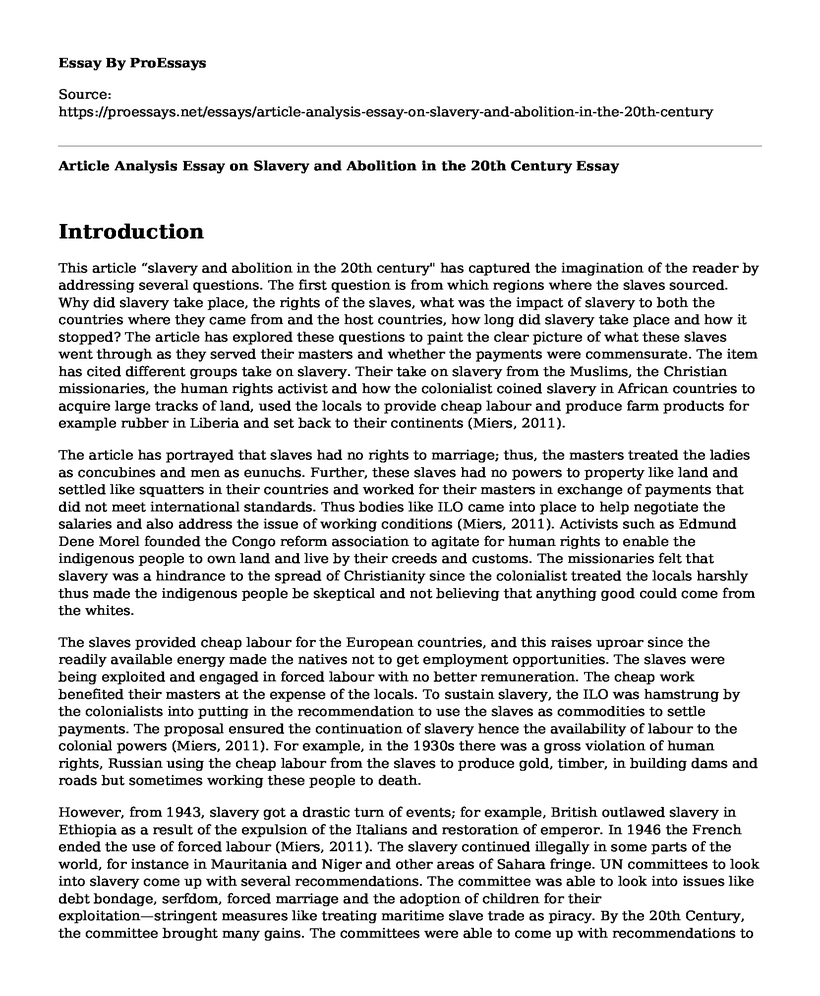Introduction
This article “slavery and abolition in the 20th century" has captured the imagination of the reader by addressing several questions. The first question is from which regions where the slaves sourced. Why did slavery take place, the rights of the slaves, what was the impact of slavery to both the countries where they came from and the host countries, how long did slavery take place and how it stopped? The article has explored these questions to paint the clear picture of what these slaves went through as they served their masters and whether the payments were commensurate. The item has cited different groups take on slavery. Their take on slavery from the Muslims, the Christian missionaries, the human rights activist and how the colonialist coined slavery in African countries to acquire large tracks of land, used the locals to provide cheap labour and produce farm products for example rubber in Liberia and set back to their continents (Miers, 2011).
The article has portrayed that slaves had no rights to marriage; thus, the masters treated the ladies as concubines and men as eunuchs. Further, these slaves had no powers to property like land and settled like squatters in their countries and worked for their masters in exchange of payments that did not meet international standards. Thus bodies like ILO came into place to help negotiate the salaries and also address the issue of working conditions (Miers, 2011). Activists such as Edmund Dene Morel founded the Congo reform association to agitate for human rights to enable the indigenous people to own land and live by their creeds and customs. The missionaries felt that slavery was a hindrance to the spread of Christianity since the colonialist treated the locals harshly thus made the indigenous people be skeptical and not believing that anything good could come from the whites.
The slaves provided cheap labour for the European countries, and this raises uproar since the readily available energy made the natives not to get employment opportunities. The slaves were being exploited and engaged in forced labour with no better remuneration. The cheap work benefited their masters at the expense of the locals. To sustain slavery, the ILO was hamstrung by the colonialists into putting in the recommendation to use the slaves as commodities to settle payments. The proposal ensured the continuation of slavery hence the availability of labour to the colonial powers (Miers, 2011). For example, in the 1930s there was a gross violation of human rights, Russian using the cheap labour from the slaves to produce gold, timber, in building dams and roads but sometimes working these people to death.
However, from 1943, slavery got a drastic turn of events; for example, British outlawed slavery in Ethiopia as a result of the expulsion of the Italians and restoration of emperor. In 1946 the French ended the use of forced labour (Miers, 2011). The slavery continued illegally in some parts of the world, for instance in Mauritania and Niger and other areas of Sahara fringe. UN committees to look into slavery come up with several recommendations. The committee was able to look into issues like debt bondage, serfdom, forced marriage and the adoption of children for their exploitation—stringent measures like treating maritime slave trade as piracy. By the 20th Century, the committee brought many gains. The committees were able to come up with recommendations to end any form of slavery. There was a declaration on the elimination of discrimination against women. A resolution to protect children which were followed by an ILO convention against child labour. Also, there was a declaration to protect women and children in emergencies and armed conflict. Furthermore, there were treaties against trafficking and a convention to protect migrant workers and their families (Miers, 2011).
Reference
Miers, S. (2011). Slavery and Abolition in the 20th Century. Slavery in the modern world: a history of political, social, and economic oppression, 1, 3. https://books.google.co.ke/books?hl=en&lr=&id=kzro5ziGRRoC&oi=fnd&pg=PA3&dq=slavery+and+abolition+in+the+20th+century+by+suzzane+miers&ots=2rg
Cite this page
Article Analysis Essay on Slavery and Abolition in the 20th Century. (2023, Aug 12). Retrieved from https://proessays.net/essays/article-analysis-essay-on-slavery-and-abolition-in-the-20th-century
If you are the original author of this essay and no longer wish to have it published on the ProEssays website, please click below to request its removal:
- The Story of an Icon: Michael Jackson Essay
- Paper Example on the Art of War by Sun Tzu: The United States Military History
- Impact of Religion and Economics on English Colonization of North America Essay
- Spartan and Athenian Archaic Societies by Using Plutarch's Life of Lycurgus and Life of Solon
- Ancient Mesopotamia Essay
- Essay Example on Robber Barons: Self-Interest Leads to Generosity
- Slavery - Free Essay Sample







